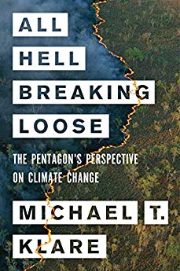Source: Lithium, Cobalt, and Rare Earths – TomDispatch.com
Solar power is largely collected by photovoltaic cells, often deployed in vast arrays, while the wind is harvested by giant turbines, typically deployed in extensive wind farms. To use electricity in transportation, cars and trucks must be equipped with advanced batteries capable of holding a charge over long distances. Each one of these devices uses substantial amounts of copper for electrical transmission, as well as a variety of other non-renewable minerals. Those wind turbines, for instance, require manganese, molybdenum, nickel, zinc, and rare-earth elements for their electrical generators, while electric vehicles (EVs) need cobalt, graphite, lithium, manganese, and rare earths for their engines and batteries.
At present, with wind and solar power accounting for only about 7% of global electricity generation and electric vehicles making up less than 1% of the cars on the road, the production of those minerals is roughly adequate to meet global demand. If, however, the U.S. and other countries really do move toward a green-energy future of the kind envisioned by President Biden, the demand for them will skyrocket and global output will fall far short of anticipated needs.
According to a recent study by the International Energy Agency (IEA), “The Role of Critical Minerals in Clean Energy Transitions,” the demand for lithium in 2040 could be 50 times greater than today and for cobalt and graphite 30 times greater if the world moves swiftly to replace oil-driven vehicles with EVs. Such rising demand will, of course, incentivize industry to develop new supplies of such minerals, but potential sources of them are limited and the process of bringing them online will be costly and complicated. In other words, the world could face significant shortages of critical materials. (“As clean energy transitions accelerate globally,” the IEA report noted ominously, “and solar panels, wind turbines, and electric cars are deployed on a growing scale, these rapidly growing markets for key minerals could be subject to price volatility, geopolitical influence, and even disruptions to supply.”)

And here’s a further complication: for a number of the most critical materials, including lithium, cobalt, and those rare-earth elements, production is highly concentrated in just a few countries, a reality that could lead to the sort of geopolitical struggles that accompanied the world’s dependence on a few major sources of oil. According to the IEA, just one country, the Democratic Republic of the Congo (DRC), currently supplies more than 80% of the world’s cobalt, and another — China — 70% of its rare-earth elements. Similarly, lithium production is largely in two countries, Argentina and Chile, which jointly account for nearly 80% of world supply, while four countries — Argentina, Chile, the DRC, and Peru — provide most of our copper. In other words, such future supplies are far more concentrated in far fewer lands than petroleum and natural gas, leading IEA analysts to worry about future struggles over the world’s access to them.
Leave a Reply